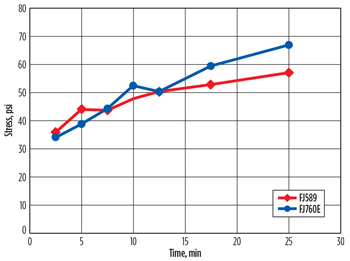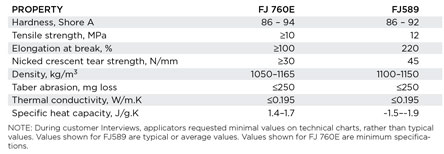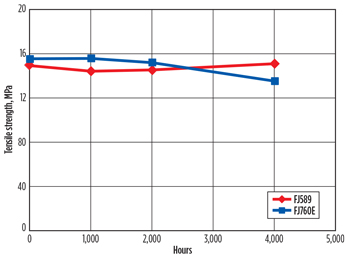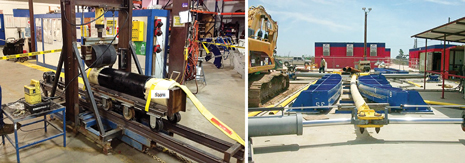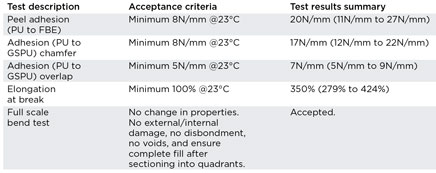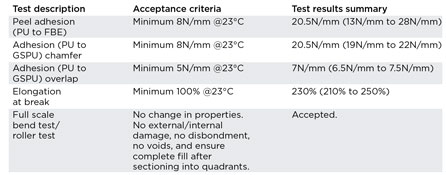Non-Hg insulation joint coating achieves environmental compliance without sacrificing performance
A collaborative, focused effort helped to develop non-Hg-catalyzed, field joint insulation material that meets and exceeds expectations, based on previous Hg-content materials.
Proven flow assurance technologies are more critical than ever, to help access oil and gas resources from more extreme environments—safely and responsibly. For decades, applicators of field joint insulation relied on the high-performance characteristics of formulations containing mercury (Hg) catalysts. Critical performance characteristics of these Hg-catalyzed, field joint materials included excellent adhesion to different substrates, outstanding hydrothermal aging, robust processability, and fast build of compressive strength, among other robust mechanical properties. Because pipe sections are connected by field joints in a multi-step process, where the slowest step determines productivity, minimizing cycle time for application of the field joint coatings is important. Legacy, Hg-catalyzed, field joint coatings typically exhibited rapid compressive strength build-up, which optimized cycle times to enable high productivity in assembling pipelines. As Hg catalysts were phased out several years ago, due to tightening environmental regulations, Dow developed field joint formulations, manufactured using non-Hg catalysts. While these first-generation, non-Hg, field joint formulations worked well enough, none quite matched the performance of legacy Hg products. The most difficult property to match was rapid development of compressive strength and other mechanical properties after application, which can potentially slow the onsite assembly SECOND-GENERATION DEVELOPMENTDow developed a second-generation, non-Hg-catalyzed, field joint coating that matched or exceeded the performance of its own legacy formulation—HYPERLAST FJ589 solid polyurethane. The first step in the developmental process was to formally survey customers across the offshore value chain, including applicators, lay contractors, offshore owners and operators. This survey identified four primary performance targets for the next-generation field joint coating:
INITIAL LAB SCREENING & TESTINGDow experts initiated an experimental program to deliver the customer requirements. Beginning in April 2012, a series of different catalysts, chain extenders, polyols and isocyanates was screened at laboratory scale in Freeport, Texas. The screening used multi-variable experiments to find formulations that matched or exceeded the cure profile, property build and final performance characteristics of the legacy, Hg-catalyzed, field joint coating. First, formulations were screened to ensure that the cured elastomer provided the necessary thermal and mechanical properties. Cup calorimetry was used to optimize catalyst type and loading, to provide the desired cure time and profile. Formulations showing a satisfactory cure profile and final mechanical properties were then screened for property development, using reactive rheometry and transient compression testing. This screening process narrowed candidates down to five formulations showing the most promise. These formulations underwent further lab-scale testing, measuring the rate of development of rheological and mechanical properties. The three most promising formulations were then selected for evaluation at the pilot scale, where a plural-component polyurethane machine was used to injection mold and bond HYPERLAST FJ 760E solid polyurethane to a 2-in. thick coating of HYPERLAST Syntactic DW512/300E GSPU on a 2-in. diameter pipe. PILOT TESTINGMachine-scale pilot testing was carried out at Dow’s application center in Birch Vale, UK. The purpose of this stage was to validate the laboratory results, using full-sized, industry-standard equipment to produce, mix and apply the test materials, as they would be mixed and applied in the field. These larger samples were then subjected to the same series of tests performed in the laboratory, including adhesion, cure profile, compressive strength, hardness, and thermal conductivity. Based on the results, FJ 760E solid polyurethane was selected as the best-performing of the three development formulations. Because machine-scale testing simulates real-world conditions, it is a strong indicator of material practicality, when applied in the field. Combined with extensive experience working with applicators and lay contractors, the challenges of mixing and applying field joint coatings onsite were understood clearly. These evaluations helped refine and define the final market value of the new materials. PHASE ONE COMPLETIONOnly a year after laboratory testing began, pilot testing and lab-scale aging studies confirmed that the FJ 760E solid polyurethane matches or exceeds all the important properties of the legacy Hg-catalyzed product. Most importantly, FJ 760E cures rapidly after the field-joint mold is filled, and it builds compressive strength quickly, comparable to the legacy Hg-catalyzed material, Fig. 1. Final thermal and mechanical properties of FJ 760E also closely match the Hg-catalyzed legacy material, as shown in Table 1.
When compared to FJ589, the FJ 760E shows excellent mechanical integrity during hydrothermal aging, shown in Fig. 2. The FJ 760E and FJ589 samples were aged in simulated seawater at 85°C, dried, and tested at 23°C.
The FJ 760E demonstrated excellent adhesion to both GSPU parent coatings and FBE substrates. Furthermore, machine-scale testing confirmed that the two-component, FJ 760E, field joint insulation material is mouldable onto anti-corrosion FBE coatings at temperatures up to 120°C. Finally, processing ratios were doubled from ±1% by weight to ±2%, using compact, mobile, standard industry equipment. PRE-QUALIFICATION TESTINGBased on strong, machine-scale test results, the FJ 760E solid polyurethane was invited to participate in pre-qualification testing by Technip for potential application in a major LLOG Exploration offshore project in the Gulf of Mexico. As the lay contractor for LLOG’s Delta House Floating Production System, Technip was interested in evaluating next-generation FJ 760E material. Technip tested and pre-qualified FJ 760E for onshore and offshore feasibility, using two different application subcontractors. A pressure roller was first used to simulate freshly coated field joints and handling at the spool base and/or a pipe laying vessel (S-Lay). A full-scale bend test was then conducted, which included anode bracket connections and repairs to the parent coating GSPU and the IMPU FJC, to simulate typical bending and pipe laying conditions in the field, Fig. 3. After these tests, the field joint cross-sections and repairs were examined visually and found to be intact. Testing results for these sample joints are listed in Tables 2 and 3.
The outcome of laboratory and onsite testing confirmed that next-generation FJ 760E replicates the mechanical, thermal and aging properties, reactivity and robust performance of legacy FJ 589. The new field joint material also demonstrated stronger adhesion to anticorrosion coatings and parent GSPU and FBE substrates, and it has the ability to meet a wider application envelope (ratio and substrate temperature) than previously possible. In both onshore and offshore qualification testing, similar results were achieved by both subcontractors, confirming FJ 760E’s suitability for use with different equipment and application processes. In all industrial qualification testing, the FJ 760E was found to meet or exceed standard acceptance criteria, demonstrating excellent adhesion, elongation and bend performance. The FJ 760E material results also indicate a significant improvement in the mechanical integrity of the field joint, resistance to handling, and performance consistency compared to previous Hg-free materials, as well as comparable performance to legacy materials. Confirmed through rigorous testing, Technip determined that the FJ 760E is suitable for use during Reel-Lay, J-Lay and S-Lay installation methods, depending on project requirements. LLOG approved the use of FJ 760E for both the offshore and onshore scope of its Reel-Lay project. The onshore production campaign of Trip 1 has been completed without significant issues or concerns; pipe spooling and pipelaying of Trip 2 was proceeding in third-quarter and fourth-quarter 2014, as planned. The development of the FJ 760E is a good example of a collaborative, focused effort involving all key stakeholders, which resulted in a successful product formulation, industrial qualification, and commercial application. This next-generation material met and exceeded Technip’s requirements and expectations, based on the previous Hg content materials. Technip’s participation from the concept development of the product was a determining factor for this success, to ensure that the installation contractor’s requirements were included and fulfilled. This collaborative approach seems to be the most appropriate way to cope with the increasing challenges in the field of subsea thermal insulation coatings for flowlines.
|
||||||||||||||||||||||||||||||||||||||||||||||||||||||


